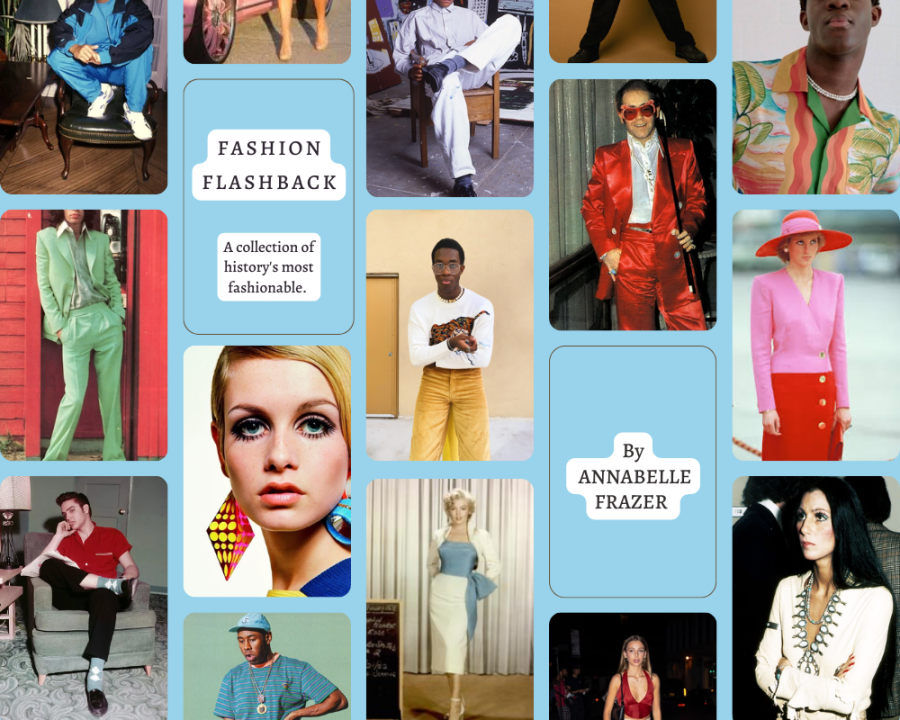Fashion Flashback: Mid-Century Mystique
October 18, 2022
The fabulous ‘50s, characterized by their rock-a-billy, drive-in theaters, and duck-and-cover mottoes, are iconically reserved as one of – if not – the – most eccentric and fashionable eras in pop-culture history.
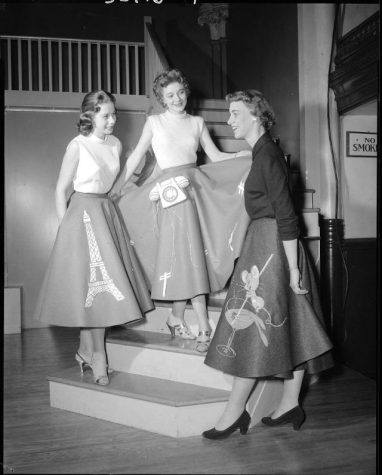 And though many of the fads once held so close to the hearts of those who flourished in their poodle-skirts and suspenders seemed to slip away with the years, some trends remain, either accentuated entirely, or flawlessly eclipsed by modernity. Whether an outfit or accessory deems full-blown retro, accompanied with a silk head scarf and cat eye Ray-Bans, or rather includes hints and references to the lavish fashion of the decade, depends entirely on the eye of the wearer, and their personal creativity.
And though many of the fads once held so close to the hearts of those who flourished in their poodle-skirts and suspenders seemed to slip away with the years, some trends remain, either accentuated entirely, or flawlessly eclipsed by modernity. Whether an outfit or accessory deems full-blown retro, accompanied with a silk head scarf and cat eye Ray-Bans, or rather includes hints and references to the lavish fashion of the decade, depends entirely on the eye of the wearer, and their personal creativity.
In this decade struck two individuals who in both their style and presence exemplified grace, integrity, and above all, eccentricity. When many were taught to deflect the unusual and jarring, it is their demonstration of (find a word) that continues to feed the expression of “style” to this very day.
Elvis Presley
Born in a two-room shotgun house East of Tupelo, Missouri, a young Elvis’ lifestyle dearly mismatched the one he made for himself years later, earning the title “The King of Rock.” In the late rock star’s youth, the shy and reserved singer/guitarist struggled with constant heckling from his peers in the rural, conservative areas of Memphis and Mississippi. To anyone who met him, it was wondrously obvious that the pale, beach-blonde boy was much different from any other young man in town.
Though being treated as an out-cast by other boys eventually became accustomed, Elvis found himself to be an even larger outlier in the very crowd he felt the most welcomed.
A startling discovery to his neighbors, Elvis grew particularly fond of the soul and roots he traced to the jazz bars and late-night speakeasies of the local black community in Memphis. Astonished by the character and passion many artists like B.B King and Big Mama Thorton, (famously known to have inspired Elvis’ rendition of Hound Dog) put into their music, Elvis began his recording career in a small shop, home to Sun Records in Memphis. Out he walked with a 10-inch lacquer, beginning his legacy as the King of Rock.
Marilyn Monroe
Widely contrasting Presley’s upbringing, Norma Jean Mortenson, the true name behind Hollywood’s favorite blonde, found her early years to be much less fortunate than what her future would soon bring. Throughout Marilyn’s childhood, her birth-mother, Gladys Pearl Baker, was frequently confined to an asylum. The product of an affair with her mother’s coworker, her father, Charles Stanley Gifford, proved absent. Brought up by two dozen sets of foster parents, Marilyn spent an amount of time reared in the Hollygrove Orphanage in Los Angeles.
Though the description of Marilyn’s early childhood seems treacherous, she describes it as one of the most stable and happy times in her life.
After beginning a career as a model in her teenage years, that experience led her to a film contract in 1946 with Fox. During her time, the first few months were composed of Marilyn training her skills in acting, singing, and dancing, before renewing her contract with Fox in 1947. Though her first few appearances were minor, her likable personality and bubbly demeanor soon granted her leading roles. By 1953, she had landed several major roles in her films, and in February of 1963, Norma Jean had officially become Marilyn Monroe. 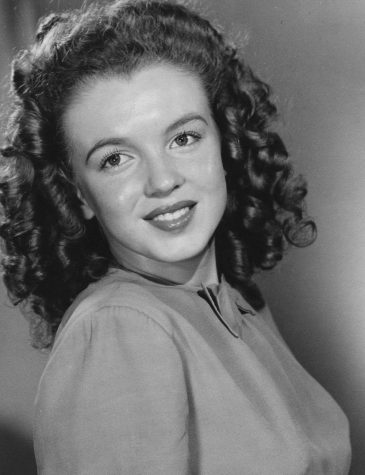
When reviewing the history of fashion, we tend to focus our attention towards whichever trends happened to be spiraling in popularity at the time. However, there is infinitely more to fashion than trends themselves. Trends, while incredibly crucial to the evolution of fashion, are not the prime definition of clothing and accessories. True, it is clothing and accessories that make up trends. But it is the individual item or accessory that compels a person to purchase it and “perform” it.
I say perform, because in my opinion, it is the duty of the wearer to do a particular item justice. A piece of clothing or an accessory, by itself, is nothing more than a piece of clothing or an accessory. It is the wearer who decides how they would like to show it off to the world, and therefore perform it. When a person cherry picks an article of clothing, decides how to style it, and executes it according to their personal preference and persona, they put on a show. It can often be captivating. When executed with confidence and self-expression, it holds the power to make heads turn. That is what composes trends. Fashion always influences trends. Trends do not always influence fashion.
Regarding their sense of style, Elvis and Marilyn shared an alike quality. They never let the trends influence them. Instead, they influenced the trends. Elvis, in the time when masculinity wished to run the world, pioneered gender-fluid fashion before it even hit the industry. Even more preposterous, Elvis’ excitement for experimenting with his wardrobe, a heavily feminine consideration, encouraged other men to share an open mind. His image of a sub-cultural cool offered many a refreshing image of self expression.
One of Elvis’ most memorable favorites – his gem-stoned jumpsuits – served as the inspiration for countless other pop culture references, including David Bowie’s many flared stage costumes, and Harry Styles’ blazon tour attire.
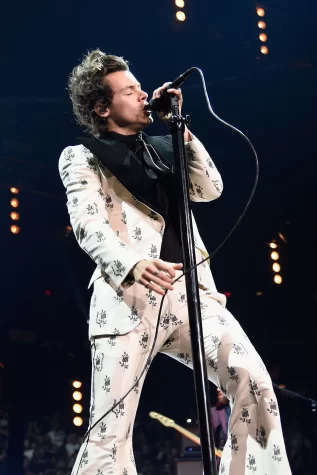
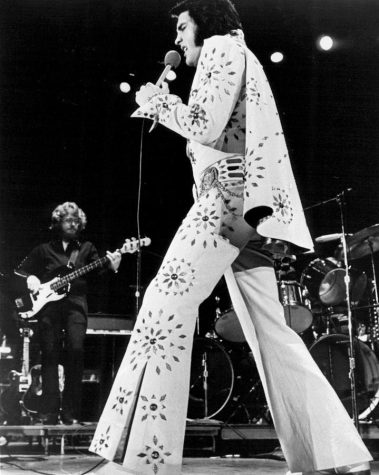 His renunciation to the conservative and orthodox fashion roles of the ’50s may be praised in today’s modern industry, but back when suspenders were as risque as men’s attire got, his fashionable divisiveness was not received well with the public. Elvis’ public image was viewed as antagonistic, as his enjoyment for makeup and sheer/lace garments were viewed as highly suggestive, and thus questionable.
His renunciation to the conservative and orthodox fashion roles of the ’50s may be praised in today’s modern industry, but back when suspenders were as risque as men’s attire got, his fashionable divisiveness was not received well with the public. Elvis’ public image was viewed as antagonistic, as his enjoyment for makeup and sheer/lace garments were viewed as highly suggestive, and thus questionable.
Elvis maintained his controversial yet entrancing pursuit until his death in 1977, and to this day, his dedication remains relevant.
Similarly, Marilyn never cared to downplay her wardrobe either. In an era of tartan pencil skirts complimenting statuesque hourglass figures as the epitome of femininity, Marilyn resorted to more casual, understated pieces like cotton blouses, cigarette trousers, and potato sacks.
Yes, potato sacks. The Hollywood actress’ wardrobe, as one story goes, was criticized in a published column, described as “tacky and cheap,” and wrote that Marilyn would have looked better wearing nothing other than a potato sack. Marilyn and her team of publisher’s response to this, was a frivolous PR photo showcasing Marilyn in just that – an Idaho potato sack.
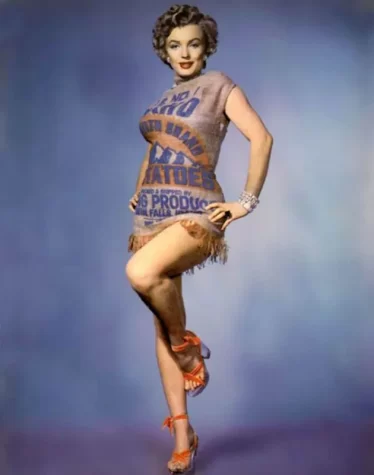
While Marilyn’s sly reply to settle this footling attack was received quite well by her fans and honored her sense of humor, the underlying root of the provocation didn’t share the same humor.
Of all the many things Marilyn has been praised and idolized for during her time in the spotlight, her devotion to body-positivity and positive self-image remains one of the most prevalent.
Of course, it was no secret that Marilyn did not fit the expectations of what women’s bodies should look like in the mid 1900s. What many adored most about her, was her disinterest in the stringent diet culture and hysterical waist measurements many women obsessed over. Much of Marilyn’s work and campaigns strove to promote femininity and beauty in all shapes and sizes, dressed in an array of garments, both conservative and provocative.
The lack of apprehension present in the individuality and poise both starlight figures introduced to the prim, demure ambiance of mid-century modernity remains essential to the introduction and renewal of creativity in the world of fashion. It is those who choose to stand out and accept judgment, rather than fit in and remain in the comfort of solidarity, who drive the concept of “style” forward.
And so, those with the courage to stand out, even in the most austere of times, are what advocate creativity, and lead inspiration into the future of fashion.


